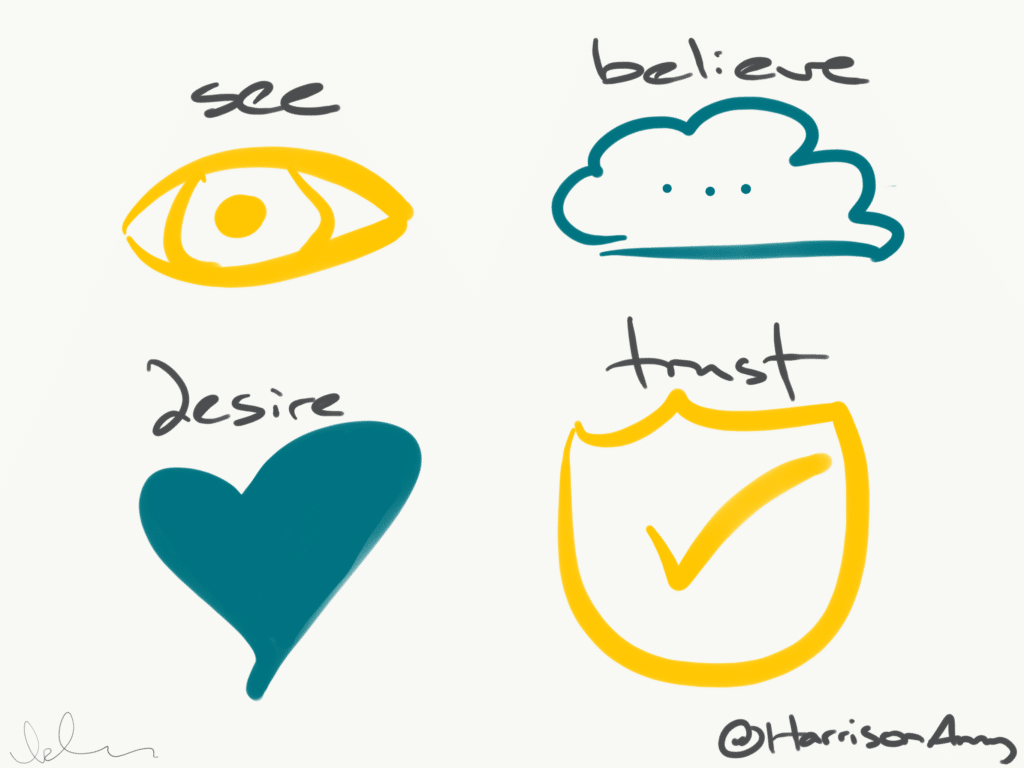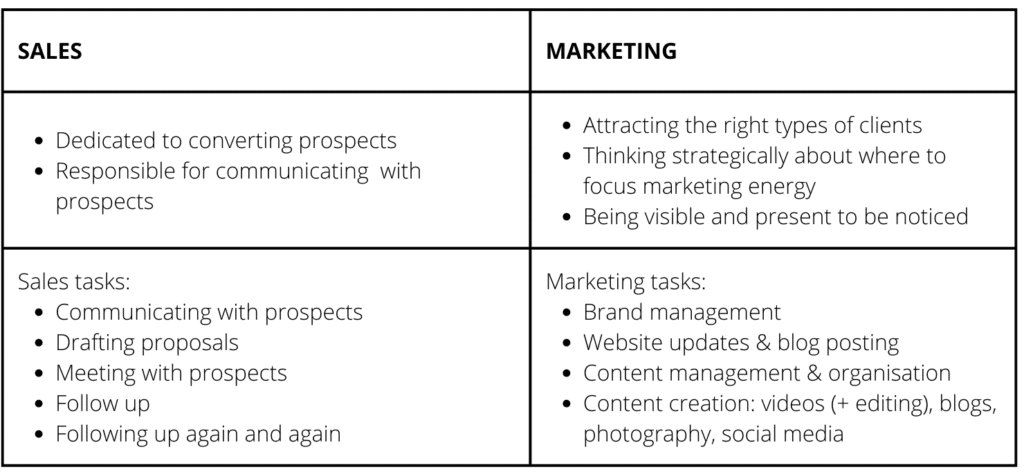
When you want to increase your revenue, or begin growing your business in a serious way, you wonder if hiring a salesperson will solve this problem. There are various reasons hiring a salesperson feels like a solution to the problems (or opportunities) you face. Maybe you find selling difficult (or even hate selling). Maybe sales takes a lot of time and you’d would like to delegate or outsource it, or move it along faster and not lose sales opportunities.
If your marketing is working properly and bringing you the right leads you’ll eventually need a salesperson to manage the sales process. But is now the right time to bring a salesperson in?
It may not be your favourite thing to do BUT as owner/director you have massive amounts of knowledge and understanding of the firm that is required to make sales. Every firm is different and this level of knowledge and skill is needed to craft a successful sales process. It takes years to build this level of understanding with someone new to your firm and therefore sales is one of the LAST things you want to delegate.
First, identify the motivation behind hiring a salesperson.
Hiring a salesperson can be risky. They need to have a high quality of experience, and fit your brand and firm. Even with that level of experience, it will take time to get that person up to speed. It’s an extra salary or payment from the business, and you know it will take time to see results. To make the best decision, think about what the real driving factor is for your sales.
- Do you want to get more leads and increase your revenue but find yourself putting sales to the bottom of your list because you find it hard or takes a lot of time?
- Are you struggling to get the right leads and feel like you’re wasting time on sales calls with prospects that really aren’t a good fit?
- Do you not like or feel like selling means pressuring people into something they may not want? This is a common concern: we all want to be sure we’re not the sleazy car salesman.
Hiring someone into a sales role won’t necessarily solve all these things.
If you have a smaller firm, you likely don’t need someone who has designated sales responsibilities. With enough knowledge and understanding of your firm, anyone on your team can support sales. As long as you and they have a clear understanding of who your ideal clients are, including their characteristics, desires, problems and goals, you can work together on sales. If you’re unclear on these things, working through foundations with PF is the best place to start.
This may not be how it is forever, but it will help you and the team learn, value the sales process, and understand how and why it works. As the firm grows you can hire someone. It may even be that you find someone internally who enjoys sales. This would help speed along the ‘getting to know you’ period someone external would have to go through.
Hiring someone to focus on sales is not a quick fix and unlikely to get you the instant results you’re looking for.
New leads take time to see you, believe you can help, have a desire to work with you and trust that you can help them. Deciding on which accountant to go with takes time and is not an impulse purchase. It could take years before a prospect signs up to work with you.

Do you really need lots of new clients?
Getting the right new leads feels like a positive thing, especially if you have plans to grow your firm. But what if instead of more clients, you focused on the opportunities for you to upserve your existing clients and increase your revenue?
After all, the likelihood of selling to an existing client is 60 – 70%, while the likelihood of selling to a new prospect is 5-20%.
Once you have earned trust and understand your client’s business inside out you can find opportunities to increase your revenue just by showing up and helping them in the best way as they see you as a trusted guide.
It’s possible small price and service increases for your existing clients will bring you to your revenue and sales goals far quicker than hiring a salesperson, as you no longer need to convert 10 new prospects a month.
The right approach to marketing will help make sales easier.
Your marketing strategy is key to sales success. Sales is focused on getting the interested prospect to sign up to work with you.
Marketing is what actually gets your ideal audience interested in your accounting services and helps you stand out from your competitors.
It’s not just about getting more leads, it’s about getting the right leads. You want your marketing draw in the right people (and send the wrong ones away)
Before focusing on selling to more people consider the quality of your leads.
If you feel like you’re not getting the right kind of leads you need to focus on marketing to the right people or your excited new sales person will convert clients you don’t really want to work with/are best placed to help.
Your website, social media, and all your marketing must clearly communicate who it is that you do (and don’t) work with. When prospects come across your firm for the first time you want them to be able to identify that you are (or not) the right accountant for them. You won’t be for everyone and the quicker you establish that the better. This will also make the new salesperson’s job so much easier: they’ll know the score, know what’s being asked of them, and know who to focus on.
If you are getting the right leads but you’re struggling to convert, there are a few things to work through before you hire a salesperson:
- Understand what your ideal clients really need from you
- Make sure you’re priced correctly for the expertise and value your team bring to clients
- Help train your team so they are confident in the value you bring, and are able to communicate that to your clients
Marketing helps you with all of these things.
At the moment you’re selling some services people don’t really understand or see the value in. Understanding your ideal audience inside out, proposing solutions to their problems or issues is key to sales. It will also reframe the way you view sales.
Instead of “selling”, in the old school way (ie telling people to buy something they may not want), think about selling as helping them. Helping them solve their problems. Helping them achieve their business and personal goals. Understanding your audience is key. Which is why the first few sessions of our Accelerator coaching group are focused on audience.
If you’re promising a top notch service but not priced to reflect that (too low) then new potential clients could think it’s all too good to be true. On the flip side, if prospects are telling you the proposed fees are too high they’re not seeing the value in what you do.
Your website, blogs, video, emails, social posts are all tools to help you communicate the value you bring to your clients. While confidence around pricing and charging the right fees often comes from the right branding. Knowing who your firm is and being able to articulate that throughout your marketing will make you feel like you are positioned correctly and CAN charge higher fees. All this content is going to help any salesperson (internal or external) sell better, and faster.
Would it work to combine sales and marketing into one role?
You may consider bundling sales and marketing together into one role. While both will help generate more revenue for your firm, they do two very different things and the responsibilities for each role are very different.

If you have a smaller firm you might be able to combine the roles of sales and marketing to begin with. But there will come a time when you need a marketing manager and someone dedicated to sales.
Before hiring, make sure you have a clear sales process in place
Whether you hire a dedicated sales person, share it between the team or take the lead yourself you need a documented process. Consider this when building your process:
Know how you qualify leads and prospects
You have control over who you work with and you can and need to say NO to the people you don’t feel are a good fit for your firm.
A diagnostic or questionnaire before any sales call will help you to pick up on any red or pink flags. But it will also help you identify the really great leads that you’re excited to work with.
Give yourself time to review and don’t feel bad if you aren’t a good fit. You can’t help everyone. Saying no will allow you to say better yeses to the right clients.
Have a clear discovery or pre- proposal meeting
From the answers on the form it may be clear what they may need. A short pre proposal meeting gives you more time with a prospect before deciding if you want to engage in a working relationship
Decide how much time you need to spend with a prospect to get to know them and decide that they’re the right client for you. Identify what you most need to know which you don’t yet from the forms and questionnaires.
Set boundaries about what this meeting is for. Set a time limit, such as15, 30, or 60 minutes, and make sure you stick to that. This will set the tone of your relationship before they even receive a proposal.
Be clear and confident with your pricing
Be clear and confident in your pricing and show this in the delivery of your proposal. If you’re feeling apprehensive or nervous about the fees you’re proposing and not confident in the value you can bring to a prospect, they will pick up on that.
Knowing and being confident in the value you bring helps you stay strong with any hagglers during a proposal meeting. Make sure you have content on all the questions you know they’ll ask, too: blog posts on how you approach pricing, a pricing methodology page, a video walkthrough of what a demo proposal could look like, frequently asked questions about price.
Know how you deliver each proposal
It’s a good idea to have a proposal prepared so you can go through it on a call with prospects. This gives you the opportunity to clearly explain and communicate all the value you and your team bring to the table. It also allows them to ask any questions and address any concerns they may have.
Prospects who are really excited to work with you may agree and sign up on the call, speeding the process up. If they aren’t ready yet, send a video after the meeting with the proposal.
Clarify the follow up process
Follow up is one of the areas most accountants struggle with. Every time we’ve run a follow up session (in Accelerator or in PF Lab), accountants share how difficult they find this. They say to themselves (or you say to yourself!):
“They’ll be in touch when they’re ready”
OR
“I was going to follow up but I got busy”
OR
“I don’t want to bug them”
Even when you do follow up, you say “I sent them an email after the call and they didn’t get back to me”. If they don’t get back to you right away that doesn’t mean they’re not interested.
Maybe they’re thinking about it, processing and maybe they just got busy at work or something’s going on personally. Until they’ve said no, it still could be a yes.
It’s worth having a few templated emails to help with follow up. You might even have some automated emails sent after a week, 2 weeks a month. This is a great way to share more information, educate and build trust while they decide.
Dropping some more personalised emails in or calls when you think of prospects is also a great touch. “I was just thinking of you” or “We just published a blog on X. I know this was an area you had some questions/interest in”
After a couple of months if they still haven’t signed up, add them to the list for your monthly newsletter to keep some sort of touch point. You never know when something you send will stand out to make them and get them to take action and want to work with you.
Create a rhythm or system for tracking prospects
If you are doing sales yourself at the moment this can be one of these tasks that slips down the priority list. But it’s important to track and keep notes of things that prospects have said on calls. It makes following up with them far easier and seem more authentic.
This could be something simple like a Gsheet where you keep a note of all of the key details, or you may include it within your CRM or practice management system for the firm.
![]()
Include sales in your onboarding for new clients
Sales doesn’t stop after the sign the proposal and letter of engagement. This is where the real work begins and you deliver on the promises you made before they signed up to work with you.
A clear, easy to follow onboarding process will make them feel secure in their decision and set the tone for your ongoing relationship. It also helps build more trust and opens up potential for up-serving and selling in the future.
How will you and the salesperson know if their role is successful?
Expect a new salesperson to take 3-6 months to get embedded into the role, and 6-12 months to function as a seamless part of your firm. Think about other team members and how even the most experienced ones need to get to know your firm and brand, values and understand the way you work and serve your clients.
This is even more important for a sales person. When they communicate with leads and prospects they are making promises about how things will be when they work with you. So it’s important they make promises that the whole team can deliver on, backed up by quality service and systems in the firm. This way it all matches with your brand. For your sales person to be successful you also need to be clear on your brand, values, and client acceptance process. If you aren’t clear on these things your new salesperson will struggle. They will simply be trying to sell stuff – not building relationships with future long term clients.
Tracking all your firm numbers is key to understanding how successful your sales operations are. It’s not only about the number of calls and meetings and proposals signed; it’s also about how the numbers connect together. Sales, marketing and the impact this has on revenue and other firm goals. It’s important to track and measure things for at least six months to a year before making any significant changes to what you’re doing.
It’s going to be tempting for you to track a salesperson’s successfulness by the number of meetings they have and proposals which are signed. But identifying ahead of time all the elements affecting success for a salesperson will help both them and you. We’ve seen so many firms hire a marketing or sales person, with great enthusiasm, only to find within 3 or 6 months that person is so disillusioned, discouraged, or burnt out because the entire expectations of the growth of the firm have been placed on their shoulders – often without the daily support they need from you and the firm. Sales is still your responsibility even if you hire a salesperson: and for the first six months we’d recommend you meet with this person (even briefly) every day. They need to be in every team meet, every divisional meet, as many client meetings as possible. They need to be part of the marketing work, and the onboarding, and understanding how it all fits together. How could they possibly sell well (without being the cheesy car salesperson) without connecting their sales work to everything you and the team do, and know?
Before jumping to hire a salesperson, really dig into why you feel you need them. Consider if this responsibility can be shared across the team. If your firm really is at the stage where you need a designated salesperson make it easy for them to come in and hit the ground running.
Make sure you are setting them up for success. Before hiring a salesperson you need to have your house in order. Be clear on who you serve and how. AND have the systems and processes in place to make it all work.
You also need to have a clear sales process mapped out. This will allow them to focus on getting comfortable and getting to know your firm and the audience you serve. The sales process doesn’t need to be perfect, it will evolve and be perfected over time.
If hiring someone external into a sales role, be patient. Like with marketing: adopting a new, effective sales system is a long game. Be prepared for it to take at least a year before you start seeing results and for things to be starting to work seamlessly.
